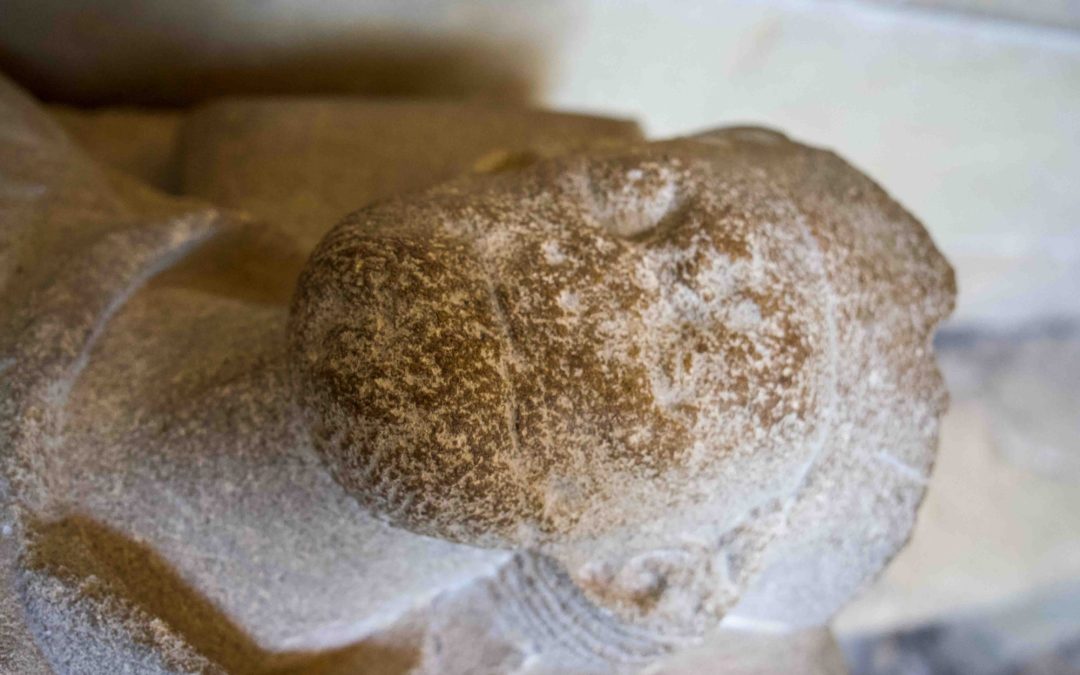On a recent visit to Wells Cathedral, I noticed the tomb effigy of Giso of Lorraine in the north aisle. He had been Bishop of Bath and Wells from 1061 to 1088. His church would have been the Anglo-Saxon cathedral which stood before the current Gothic one.
In 909, the large diocese of Sherborne was divided into three smaller ones. The minster at Wells became the cathedral of the new diocese covering Somerset with a new bishopric created.

Giso of Lorraine Tomb Effigy – moved to the Gothic Cathedral from the Anglo-Saxon Cathedral
Giso had been chaplain to Edward the Confessor. He managed to successfully retain his position during the Norman invasion of 1066 and subsequent Conquest. His northern European background and links probably being a significant asset to his continuation as bishop. Details of his life in Wells were recorded in the short history of Wells Cathedral, known as the Historiola de primordiis episcopatus Somersetensis.[i]
It is curious to imagine this man arriving in Wells in the early 1060s to prepare for his position. His tomb was opened in 1979 and revealed he had been a tall man with a broad chest.[ii] This imposing and energetic man must have been a shock to the small number of impoverished canons he met upon his arrival. Wells was never a monastic institution, and he would have found maybe four or five secular canons.[iii]

Giso of Lorraine’s Tomb Effigy Face
Both King Edward and Giso were keen to bring continental culture into England. Giso brought to Wells new liturgical ideas from the continent and the cults of various saints popular in Flanders, Burgundy, and Germany. This included Ursula and the eleven thousand virgins, Giles, Florian, Faith, and Mary Magdalen.[iv]
He also set about administrative reforms and improving the cathedral. He built a dormitory, refectory and cloister and directed the canons to live under canonical rule (which may have been the rule of Aachen).[v]He obtained grants of lands from the king which was known as the Terra Gisonis to provide support for the church and chapter, so the canons were no longer reduced to begging for alms. This included property at Wedmore, Milverton and Litton. For the new position of archdeacon, he secured the church of Yatton along with land.[vi] He organised the community to consist of a provost, an archdeacon, and a small number of canons.[vii]
I was initially struck by his draping robes, and it reminded me of classical statues. In Rome at the Borghese gallery is a 1st century BC statue of the Emperor Augustus as Pontifex Maximus when he appointed himself as chief high priest of the College of Pontiffs in ancient Rome. It had been a religious position in the early Roman Republic but in the Roman Imperial Period the position was assumed by the emperor.

Emperor Augustus in his priestly robes as Pontifex Maximus
Whilst Giso’s are not as realistic and voluminous as Augustus’s robes, it did make me think of the question – did Giso visit Rome? I think we sometimes forget that England was part of Christendom that had a form of unifying Europe and that the writings of the classical world impacted the development of that Christian world.
Giso did visit Rome. In 1061, Duduc, the then bishop of Wells died and Giso was appointed his successor. Instead of looking to be consecrated by Stigand, archbishop of Canterbury, who had been excommunicated at the time, he travelled to Rome. He was accompanied by Walter of Lorraine (d. 1079) who had been chaplain to Edward the Confessor’s wife, Edith of Wessex. Walter was also seeking consecration – as bishop of Hereford. They were to be consecrated by Nicholas II at his Easter synod on the 15 April 1061.[viii]
Earl Tostig, Harold Godwinson’s brother, travelled with them.[ix] Later he was killed at the Battle of Stamford Bridge by Harold’s forces in 1066 where he was in support of the Norwegian king, Harald Hardrada’s invasion of England.
Giso saw himself as a reformer towards something more pan-European and cultured. What the canons and people of Wells and Somerset thought we don’t know but perhaps it was a challenge for them. Giso had the favour of the king, and had authority directly from the pope, Nicholas II. There is a letter in the cathedral archives from Nicholas II confirming Giso’s rights and episcopal property.
His successor, John of Tours (bishop 1088-1122) moved the see to Bath in c. 1089. He undid a lot of Giso’s work, demolishing his building works and reversing his decision on the canonical rule, whereby limiting their rights, and forcing them back to living in the town. It wasn’t until 1245 that Wells cathedral got back a bishop’s throne.[x]
NOTES
[i] Julia Barrow, ‘Giso (d. 1088)’, Oxford Dictionary of National Biography, Oxford University Press, 2004: online edn, Sep 2004, https://doi.org/10.1093/ref:odnb/10778 [accessed 29 April 2023].
[ii] Julia Barrow, ‘Giso (d. 1088)’.
[iii] Simon Garrett & Anne Crawford, The People Who Made Wells Cathedral: More than Stone & Glass, (United Kingdom: Heritage Films & Publications, 2013), p. 19.
[iv] Julia Barrow, ‘Giso (d. 1088)’.
[v] Barrow, ‘Giso (d. 1088)’.
[vi] Barrow, ‘Giso (d. 1088)’.
[vii] ‘Introduction’, in Fasti Ecclesiae Anglicanae 1066-1300: Volume 7, Bath and Wells, ed. Diana E Greenway (London, 2001), pp. xxi-xxix. British History Online http://www.british-history.ac.uk/fasti-ecclesiae/1066-1300/vol7/xxi-xxix [accessed 30 April 2023].
[viii] Barrow, ‘Giso (d. 1088)’.
[ix] Barrow, ‘Giso (d. 1088)’.
[x] ‘Introduction’, in Fasti Ecclesiae Anglicanae 1066-1300: Volume 7, Bath and Wells, ed. Diana E Greenway (London, 2001).
BIBLIOGRAPHY
Barrow, Julia, ‘Giso (d. 1088)’, Oxford Dictionary of National Biography, Oxford University Press, 2004: online edn, Sep 2004, https://doi.org/10.1093/ref:odnb/10778 [accessed 29 April 2023]
Garrett, Simon & Anne Crawford, The People Who Made Wells Cathedral: More than Stone & Glass, (United Kingdom: Heritage Films & Publications, 2013)
‘Introduction’, in Fasti Ecclesiae Anglicanae 1066-1300: Volume 7, Bath and Wells, ed. Diana E Greenway (London, 2001), pp. xxi-xxix. British History Online http://www.british-history.ac.uk/fasti-ecclesiae/1066-1300/vol7/xxi-xxix [accessed 30 April 2023]

